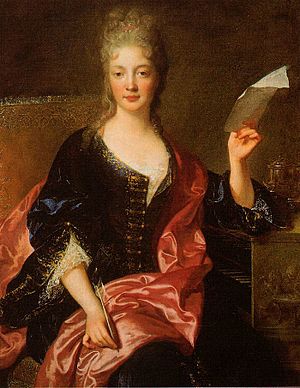Élisabeth Jacquet de La Guerre facts for kids
Quick facts for kids
Élisabeth Jacquet de La Guerre
|
|
|---|---|

Élisabeth Jacquet de La Guerre painted by François de Troy
|
|
| Born | 17 March 1665 |
| Died | 27 June 1729 (aged 64) |
Élisabeth Claude Jacquet de La Guerre (born March 17, 1665 – died June 27, 1729) was a famous French musician. She was a talented harpsichordist and a well-known composer.
Her Life and Music
Élisabeth-Claude Jacquet de La Guerre was born in Paris, France, on March 17, 1665. She came from a family of musicians and people who made musical instruments. Her grandfather and father both made harpsichords. Her father, Claude Jacquet, taught all his children about music. This strong family background helped her start her amazing musical journey.
Élisabeth began her musical training with her father. When she was only five years old, King Louis XIV noticed her incredible talent. She was a child prodigy, meaning she was extremely gifted at a very young age. This led to her becoming a musician in the King's court at his palace, Versailles. She wrote many of her musical pieces for the King.
As a teenager, she joined the French royal court. The King's mistress, Madame de Montespan, oversaw her education. Élisabeth stayed with the royal court until it moved to Versailles. In 1684, she married Marin de La Guerre, an organist. After her marriage, she continued to teach, compose, and give concerts. Her performances in Paris were very popular.
Élisabeth Jacquet de La Guerre was one of the few well-known female composers of her time. She wrote many different kinds of music. A famous writer, Évrard Titon du Tillet, praised her greatly. He said she could play amazing music without planning it first. He wrote that she could improvise for half an hour, charming everyone who listened.
Her first published work was a collection of harpsichord pieces in 1687. These were some of the only harpsichord pieces printed in France during the 1600s. Around 1691, she composed a ballet called Les Jeux à l'honneur de la victoire, but this music is now lost.
On March 15, 1694, her opera Céphale et Procris was performed in Paris. This was the first opera written by a woman to be performed in France. It was a five-act tragédie lyrique, which is a type of French opera. She also tried writing Italian-style music, like sonatas and cantatas. In 1695, she wrote some trio sonatas. These were among the first sonatas written by French composers.
Her opera Céphale et Procris was not very successful, only having a few performances. People at the time thought the opera focused too much on the story and not enough on the music. This was different from what French audiences expected. This made her stop writing operas.
During the next few years, Élisabeth faced many personal losses. Her only son died when he was ten years old. Her mother, father, husband, and brother also passed away. Despite these sad events, she kept performing.
In 1707, she published a new collection of harpsichord pieces. These pieces could also be played on the violin. She also released six sonatas for violin and harpsichord. These works were special because the harpsichord played a very important part, not just as accompaniment. Jean-Philippe Rameau later wrote similar pieces.
King Louis XIV continued to admire and support her music. In her 1707 work, she wrote to the King: "Such happiness for me, Sire, if my latest work may receive as glorious a reception from Your Majesty as I have enjoyed almost from the cradle." She thanked him for always encouraging her talent.
She returned to writing vocal music with two books of Cantates françoises in 1708 and 1711. These were French songs based on stories from the Bible. Her last published work was a collection of secular Cantates françoises around 1715. When she died, she owned three harpsichords.
Élisabeth Jacquet de La Guerre passed away in Paris in 1729, at the age of 64.
Her Important Works
Many of Élisabeth Jacquet de La Guerre's early sonatas are only found in handwritten copies in Paris. It is believed that most of her other works were published during her lifetime.
Stage Music
- Les jeux à l'honneur de la victoire (a ballet, around 1691), now lost.
- Céphale et Procris (an opera, 1694).
Vocal Music
- Cantates françoises sur des sujets tirez de l'Ecriture, livre I (published in Paris, 1708). This book included cantatas about:
- Esther
- The Crossing of the Red Sea
- Jacob and Rachel
- Jonah
- Susanna and the Elders
- Judith
- Cantates françoises, livre II (published in Paris, 1711). This book included cantatas about:
- Adam
- The Rebuilt Temple
- The Flood
- Joseph
- Jephthah
- Samson
- La musette, ou Les bergers de Suresne (Paris, 1713).
- Cantates françoises (Paris, around 1715). This collection had three cantatas and one funny duet.
- Te Deum (1721, now lost).
- Various songs published in Recueil d'airs sérieux et à boire (1710–1724).
Instrumental Music
- Les pièces de clavessin (Paris, 1687). This included four suites for harpsichord.
- Pièces de clavecin qui peuvent se jouer sur le violon (Paris, 1707). This included two suites for harpsichord that could also be played on the violin.
- Six Sonatas for violin and harpsichord (Paris, 1707).
See also
 In Spanish: Élisabeth Jacquet de La Guerre para niños
In Spanish: Élisabeth Jacquet de La Guerre para niños

